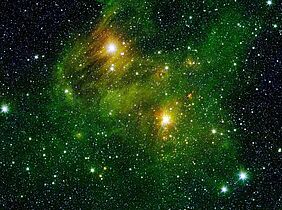Polycyclic aromatic hydrocarbons (PAHs) are chemical compounds which can be found naturally in hydrocarbons such as coal and oil, as well as in dead carbon-rich stars after they have exploded. The mass created in the course of the explosion can be regarded as a precursor to the most basic forms of the carbon molecules which are important for creating life on the Earth. PAHs in the form of soot are also some of the world’s most aggressive pollutants emitted into the environment.
The origins of formation of the PAHs such as the benzene ring have now (2021) been the focus of scientific studies of a couple of astrophysicists at Lawrence Berkeley National Laboratory. With the help of laboratory experiments they were able to conduct the first real-time measurements of the free radical propargyl reacting under cosmic conditions and also looked at how elementary carbon and hydrogen atoms combined to form elementary benzene rings.
The researchers believe that their findings might have a decisive impact on how we perceive the evolution of the universe regarding the growth of carbon compounds. Their insights might also help to make combustion engines for cars cleaner. The current research focuses on the free radical propargyl out of which, scientists believe, the first benzene molecule in our universe was created. To initiate the so-called radical propargyl self-reaction under astrochemical and combustion conditions the scientists used a high-temperature, small chemical reactor called a “hot nozzle” to imitate the high-pressure, high-temperature environment inside a combustion engine as well as the hydrocarbon-rich atmosphere of Saturn’s moon Titan. Then, they observed how isomers formed from two propargyl radicals and eventually became a benzene ring. The hot-nozzle technique uses vacuum ultraviolet (VUV) spectroscopy to detect individual isomers. The researchers controlled the process so that they would be able to capture the propargyl radical self-reaction which transpires very quickly before larger PAHs and subsequent soot could form.
Studies on improving combustion engines with the help of free radicals have been carried out for several years. In 2016, scientists used laser pump-probe spectroscopy to study how hydroxyl free radicals reacted with polycyclic aromatic hydrocarbon precursor molecules in a quasi-static gas cell. Hydroxyl free radicals were produced by pulsed laser photolysis (PLP) and their concentration was monitored using a frequency-doubled tuneable dye laser placed in a perpendicular position in relation to the photolysis laser. The off-resonance fluorescence from the hydroxyl free radicals was assembled in a photomultiplier tube (PMT) which was positioned in an orthogonal angle to the photolysis and probe laser beams.
In 2017, scientists analysed the photodissociation of several combustion relevant radical molecules (benzyl radicals). The experiments were conducted using a molecular beam photofragment translational spectroscopy instrument. Flash pyrolysis was employed to generate radicals which were embedded in a pulsed molecular beam. The radicals were then photodissociated and the products were analysed with a rotatable mass spectrometer. The scientists witnessed two dissociation states for each radical: the benzyl radical dissociated into H + C7H6 and CH3+ C6H4 and the cyclopentadienyl radical dissociated to H + C5H4 and C3H3+ C2H2. One of the goals of this research was to understand exactly what processes take place during combustion of free radicals, such as in a car engine or power plant, as well as to analyse combustion conditions that are more sustainable for the environment and human health.
The findings of the study might lead to several improvements in the way we produce and harness energy: first of all, they help us understand how the growth of carbon compounds transpired in the beginnings of the universe. These insights into molecular growth might also facilitate the production of cleaner combustion systems as the formation of pollutants could be reduced and thus the environment protected at the same time.
Designing more environmentally-friendly engines is especially important as it might still take many years before the comprehensive use of 100% emission-free vehicles is implemented. However, if vehicles and also airplanes could be equipped with cleaner engines this would mean a large step towards a more sustainable environment.
